Whaddaya mean, too hot?

Many aquarium fishes are maintained under conditions they would never experience in nature. © Elke Weiand
Rüdiger Rautenberg with an alternative look at aquarium heating and how following the ‘rules’ may be costing you money…
First I have to make clear that I will presuppose a few facts to keep this write-up at a bearable length.
- The fish tank in question is situated in those parts of the world with a fairly moderate clime. That excludes on the cold extreme both pole caps, inner Siberia, parts of Greenland and basically all places, where ice and snow never melt. The other end of the stick would be the Iranian desert, Death Valley, the Fish River Canyon and maybe parts of Spain as examples of places with perhaps just a bit too much sun.
- Within the suitable regions said tank is located within a moderately well-built abode.
- The owner of the fish tank knows how to operate a thermometer and is willing to do so at reasonably regular intervals.
- When I talk about “additional heating” I mean any purpose-built aquarium heating devices such as, e.g., a heater stat.
Taking those basics into account, I will now argue that a vast number of commonly kept fish species can be maintained without any additional heating at all and further that the majority of commonly kept species can be maintained with limited additional heating only during about 3 (the coldest) months of the year.
In reverse I will argue that most fish species kept in our aquaria are kept too warm.
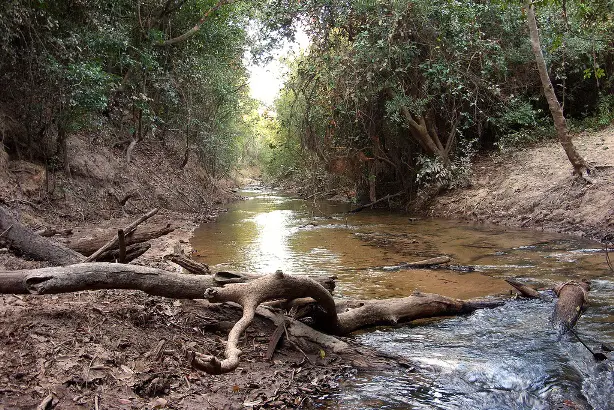
A forest tributary in the rio Tocantins basin, Brazil. Such shaded streams can contain suprisingly cool water. © Adam Carvalho
Er, did you dream that up dude?
Before I get to factual examples and practical considerations, I’d like to shed some light on how I came to question general temperature recommendations and my thoughts behind it.
How do we come to have all these wonderful temperature recommendations, which by the way as I’ll show later vary quite significantly for any given species depending on which source we have consulted.
Now, there is of course the climate data collected all over the world, even in the most inhospitable of all places. But temperature we get from those tend to be air temperatures not water temperatures.
Then, there are the people who collect fish. Not those who do it professionally mind you. They usually are poor peasants who can hardly afford the inevitable net and don’t bother with such profanities.
It’s scientists, out there to discover new species, ambitious and equally well off aquarists, there to collect certain species (of course often hoping to discover a new species too) and perhaps the odd unsuspecting tourist with the once in a lifetime chance to catch their very own Siamese Fighter or similar (and no clue that there could be new species to be discovered).

These images of the same spot in the Western Ghats mountains, southern India shows the contrast between wet and dry seasons. © Arne Hückelheim
Let’s assume all of them dip the temp-stick into the puddle and actually somehow preserve the result. Surely that should give us a fairly accurate idea of how to set the temperature in our fish tank?
What if all temperature samples were taken within a fairly narrow time window of the year? General vacation time would be such a narrow window as would be travelling at times of bearable climatic conditions. And after all, many of the known collecting sites are not accessible for months on end, e.g., due to weather conditions, flooding etc.
What if the spot where the fish was caught isn’t where it usually dwells but rather the spot it ended up by hunting after prey or on it’s flight from a predator.
Unfortunately we just netted it before it could get back to where it would feel a lot more comfortable. I believe I don’t have to mention that temperatures in any given body of water are not uniform and differences by quite a margin are the norm.
If we look at an aerial photo of the Amazon basin for instance we will of course see the majestic river itself and a number of the larger tributaries. What we don’t see are innumerable medium sized and small tributaries, which are well hidden under a dense canopy of rainforest.
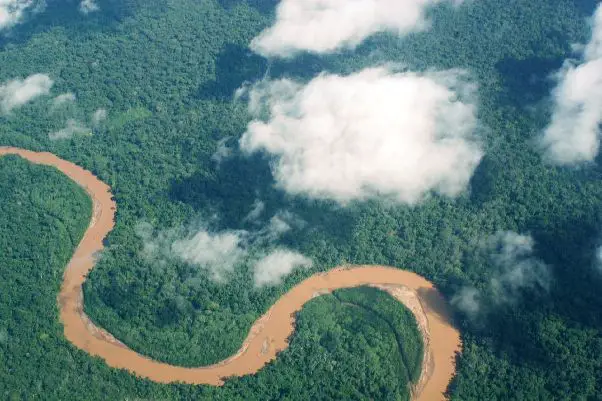
A classic Amazon view, but many of the fish we keep inhabit tributaries hidden beneath the tree canopy and shaded from the sun. © Jonathan Lewis
That in turn means, these rivers and streams don’t get any direct sun light, which would logically make them cooler compared to those those that do.
The fact that the majority of “aquarium sized” fish species are collected from these sheltered waterways doesn’t only influence temperature considerations but will also play its part in a later instalment of this series about lighting.
Concluding this prelude I’d like to introduce one example of fish species, which will demonstrate without a doubt that questioning the “facts” isn’t a bad thing at all.
Pseudomugil gertrudae, the spotted blue eye, a beautiful fish indeed.
I have taken temperature and pH recommendations from 3 different internet databases and one online shop, which of course will all remain anonymous:
db1. Temp. 24 – 28° C pH: 6.0 – 7.5
db2. Temp. 25 – 30° C pH: 5.5 – 8.5
db3. Temp. 23 – 30° C pH: 3.8 – 7.8
shop. Temp. 20 – 26° C pH: 6.5 – 7.5
At a closer look and a quick thought, these can only be parameters taken from different breeders with different approaches.
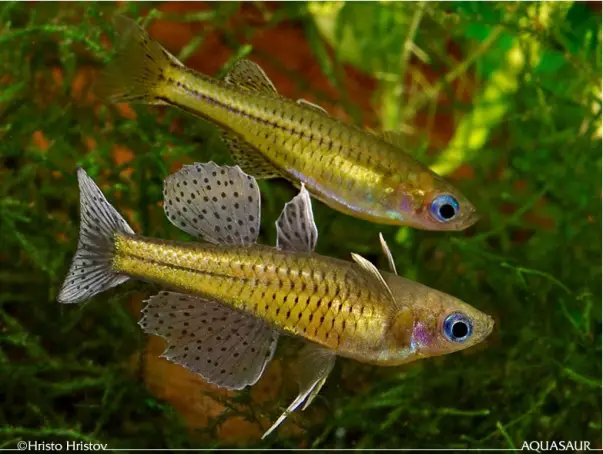
Pseudomugil gertrudae can tolerate relatively low temperatures according to field observations. © Hristo Hristov
Temperatures and pH measured at the actual different collection sites as found here show something quite different.
Temp. 12 – 34° C pH: 3.68 – 9.4
Database 3 is closest with the widest pH spectrum whereas the shop sort of convinces by allowing for lower temperatures. The fact is however that P. gertrudae certainly is a species that could be kept and maintained long-term without additional heating in most scenarios, as shown by actual and factual parameters.
So you want me to dump that heater?
Not at all. It’s always good to have a spare piece of equipment collecting dust somewhere.
But seriously, let’s see what it looks like at my place. I currently run 7 fish tanks of various sizes. But I only have 2 heaters, 100 and 50 watts, on temporary duty in my 160 l South American set up and my 54 l Dwarf Puffer tank respectively.
Temporary means they get switched on beginning of November and switched off end of January, latest mid February if winter is really long.
Now, does that mean my fishes get cold? I haven’t seen them getting their socks out so far. And there’s no need for that either. The S.A. tank sits in the dining room, which is obviously heated to a habitable temperature of about 20° C.
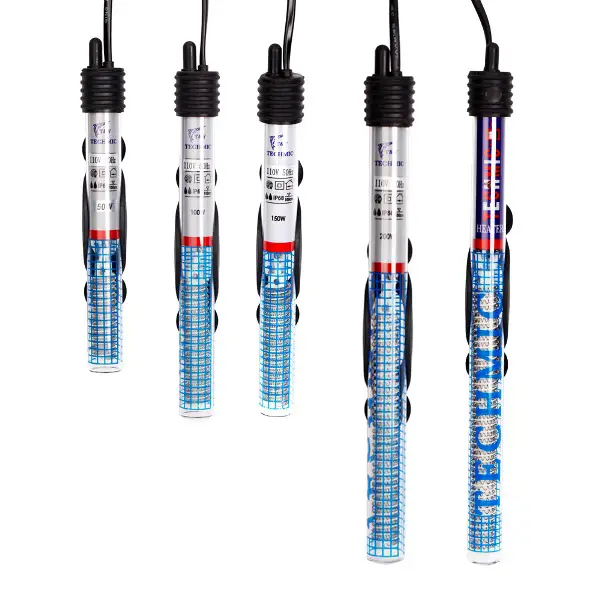
Aquarium heaterstats are undoubtedly useful bits of kit, but we may rely on them unecessarily at times.
All other tanks are in my study come home office. Here too temperatures are kept at a bearable level, which in my case is a snug 19° C during the day. In addition, both “heated” tanks have closed light fittings, 21 watts T5 for the large one and a modified 16 watts (2x8w) CFL for the smaller.
At an ambient temperature of 19° C those lights raise the water temperatures by 3 and 4° C respectively. You will see that the heaters don’t have to work too hard to get the water to the desired 24 ° C.
In those periods leading up to switching the heaters on and from switching off to really warm weather, water temperatures can go down to 21 and briefly even to 19° C. None of my fished has ever shown any damage or discomfort due to low temperatures, quite the opposite, they are vigorous and strong specimens indeed.
I believe that generally recommended temps are actually breeding temps and as such not ideal for general, long term maintenance. If our fishes are constantly in breeding condition, triggered by the warm water, they are constantly suffering a huge amount of stress.
Putting on their “Sunday best”, courting, defending a territory, the actual spawning and, in some cases, caring for the brood and that over and over again take a lot out of the males. But the females too burn out quickly due to continuous harassment by the males and constant egg production.
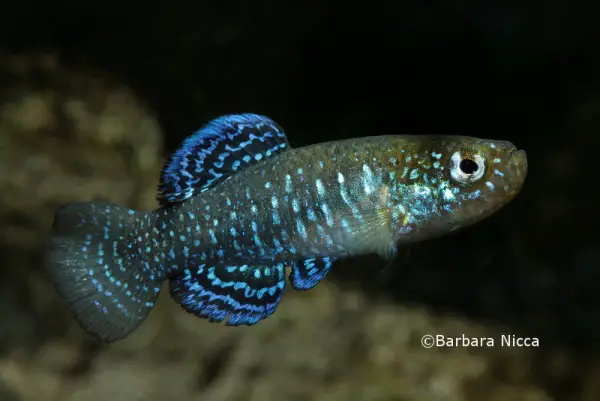
Some fishes, such as Aphanius mento, undergo significant seasonal variations in temperature but tend to be maintained at a constant value in aquaria. © Barbara Nicca
My experience shows that keeping my fishes well below the recommended temperature for most of the year only has advantages. They are lively and active, look strong and show great colours, and they seem to get to a much higher life expectancy.
But then again, cooler water slows down the metabolism as we all know and that in turn prolongs the lifespan.
When temperatures rise up to and sometimes above their ideal breeding temps, they look after the fun side of business too and except for my Otocinclus spp. and those fishes I acquired only recently, every species I am presently keeping have spawned in their regular set up.
Badis badis regularly spawn and successfully raise young at 19° C, all Danio spp. spawn continuously at the same temperature so that I actually cool them down to 16° C for three months at least, Crossocheilus reticulatus are courting at 19° C unfortunately without subsequent spawning activities so far.
One of my Pangio semicincta females has gotten curiously full around the hips an I only had that group for about 4 weeks now. Doesn’t that somehow indicate, “Not too bad old chap”?
And let me add one bit of info that I unfortunately cannot conclusively tie to lower water temperatures but I also cannot see it as a coincidence that, as a matter of fact, I did never, since I am proceeding as described, have had any fish disease in any of my tanks, none whatsoever.
What’s that you mumbled about saving money?
Right, if I heated all my tanks to the generally recommended temperatures I’d have a bill just for the aquarium heaters of roughly € 680,- per annum whereas my actual bill for the same purpose is less than € 30,- per annum. That is a lot of fishes to buy!!
Was that it?
To finish this up I’d like to say, as someone who has lived and spent some time in the tropics, that even there things are not as constant and always level as they are made out to be.
There are more factors influencing water temperature for instance than just continuous sunshine. Or as an old friend of mine would say: “It ain’ warm where the sun cain’ git.”
What else happens “where the sun cain’ git” I’ll tell you about in the next episode.
Category: Articles, Beginner's Guide | Tags: aquarium, aquarium heating, fish tank, heaterstat, tropical aquarium | 18 comments »




January 23rd, 2013 at 8:48 pm
Great article Rudiger, thanks! I unplugged all of the heaters in my 14 tanks last Spring as an experiment. The only real effect that I clearly noticed was that the cyanobacteria that I was battling in one particular tank disappeared. I assume that it didn’t like the varying temps. Of course when Fall arrived and I plugged the heaters in it re-appeared! I’ve read more than one opinion that constant temps in an aquarium are beneficial to harmful bacteria i.e. columnaris, mycobacteria.
January 24th, 2013 at 12:37 pm
Thanx Jim.
Would be great if you could tell us at what temperature you usually maintain your tanks and by how much the temps dropped after you switched the heaters off.
I wish I had your strain of cyano then as mine are not at all disturbed by a drop in temperature. As a matter of fact, hey are not bothered by anything I do to get rid of them.
I think it is obvious even to us non-scientists that a constantly warm milieu is a happy breeding ground for all kind of nasties.
January 24th, 2013 at 1:03 pm
Yep, great stuff Rudi and so much of it makes perfect sense.
I wonder who first decided that the majority of freshwater fishes should be maintained at 24-26°C when virtually every species undergoes a daily fluctuation in the wild?
My tank in the house is unheated and has Rhinogobius rubromaculatus, R. cf. wui, Erromyzon sp. ‘red spots’ and Badis ferrarisi.
It’s currently sitting at 16°C, in the summer reached 33°C and the fish look and feed fine although some Gastromyzon spp. loaches were lost during my holiday in the heat of August.
I also have three species of Aphanius on the terrace which again can withstand 30°+ in summer and have been under snow twice so far in winter, although they are an extreme case!
January 24th, 2013 at 3:43 pm
I usually keep my tanks between 74-78f. Unfortunately I got busy last Summer and didn’t record any details. Normal temps here that time of year would be high 40s – mid 70s. My apt. faces South so there have been occasions where I had to add a fan & turn the lights off.
http://www.weather.com/weather/wxclimatology/monthly/graph/USWA0028
January 24th, 2013 at 4:26 pm
I think it’s great that there’s some discussion on this subject!!
@ Matt: I can imagine that Gastromyzon spp. don’t take too kindly on temps above 30° C for more than a couple of hours. It’s always sad though to loose a fish that way.
Quote: ………. although they are an extreme case!”
It sure looks like it at first glance. But is that really the exception?? I’ve got an acquaintance who is incidentally one of the sales guys in one of my LFSs. He’s a killie nut but frequently travels to South America to collect other species too. He told me that on his last trip they caught what he believes to be an undiscribed Corydoras sp. under about 15 mm of ice!! I know it sounds like a made up story but it is a fact!
@ Jim: I am not familiar with your stock but 23° to 25° C (converted that myself, how proud I am) is, compared to what I have on record for general temperature ranges in fish tanks, fairly low already. When I calculate an average of all records I have collected from fellow fish keepers throughout the years, it gives me an astonishing 27° to 30° C or, for you, 79 to 86 F.
In you case I gather, with a south facing apt., you invest more energy in cooling those tanks down than heating them?
Cheers
R.
January 24th, 2013 at 7:53 pm
Have you seen this blog Rudi? This changed my thinking about gastromyzon sp.
Temperature: 27.6°C
pH: 7.5
Hardness: 6°dKH (approx. 107 ppm KH)
Sampling time: 11.30 pm
Date: 13th June 2009
Climate description: Drought
Please this is for information purpose only. Parameters may varies during climate change. It is not advisable to comply exactly to the above parameters, thank you 🙂
30°C for G. monticola habitat? Read more bout it in the next post
http://borneosucker.blogspot.com/2009/06/borneo-sucker-trip-13th-june-2009-water.html
January 24th, 2013 at 11:40 pm
Hi Jim, I didn’t know that blog, but I seem to remember to have read an article once about that trip. And as in the blog, that guy doesn’t volunteer any more water parameters. But he says in the post you quote, “climate description: drought” and in the very next post hes says “boy, it must have rained a lot”.
So it’s basically what we are discussing here. There’s no such thing as constant conditions. And when he expected to find temperatures at 30* C at the next collection site, after that rain it might have been just 22* C. It all suggests that the latitude of suitable maintenance parameters forvany given species is a lot broader than we generally assume.
And I am pretty sure that the little suckers in that case will look after reproduction in the described conditions whereas they’ll look after themselves when the rains and masses of water cool everything down again.
So I still believe in generally keeping fishes at the cool end of the spectrum and summer will look after the rest.
January 25th, 2013 at 12:22 am
I agree with your conclusions. I think the important element when temps get high is oxygenation. In most streams it’s probably not an issue. But in an aquarium, a closed system, it’s up to us to supply water movement, surface agitation etc. for enhancement.
January 25th, 2013 at 3:00 pm
[…] Re: Heating issues. Welcome to APC! That is a small tank, so even a low wattage heater should be enough. Heater malfunctions are common, yours might simply not be working correctly. Take it back and exchange for a new one. Depending on what kind of fish you plan to keep, you may not need a heater. There is evidence that we keep most of our aquaria too warm for the long-term health of plants and fish. There is a good article at Seriously Fish on this topic: https://www.seriouslyfish.com/whaddaya-mean-too-hot/ […]
February 3rd, 2013 at 10:28 am
Good to see this being put out there for mainstream consumption! 🙂
My fish hut has been at a lower temperature all winter. As well as costing a bit less in electricity during the coldest part of the year it also gives the fish a long deserved break from spawning etc. An aquarium heater keeps the water at a constant temperature 24×7, 365 days a year and that can’t be a good thing. I seem to remember head and lateral line disease being mentioned as a result of constant, unchanging temperatures?
My Channa aurantimaculata pair have been in winter rest (brumation?) since the start of October and have seen temperatures as low as 12 or 13C and still come to the front of the glass in the hope of a worm when they see me!
February 3rd, 2013 at 11:40 am
This is a very interesting subject [Thanks Rudiger] and I think it should be hugely beneficial to most aquarists that run more than a few tanks ,the only thing that slightly worries me is the situation where the people who decide what can and cannot be kept in aquariums i.e. the fishes that can live in our temps and are deemed a possible threat to native environments ? there are a whole load of North American fishes that aren’t allowed to be kept in England for those reasons ,though I’ve heard a horror story about some Indian Garras being destroyed at the airport because they were labeled as Tor 🙁 I mean even if you might agree with these laws its scary to think that whomever might be in charge couldn’t tell the difference between a Garra and a Masseer 🙁
but I’m probably being over cautious ?
Sorry if this thows a dampener on a brilliantly vital subject !
February 9th, 2013 at 9:16 pm
Hello to everyone,
Thanks for this very interesting article.
I’ve lowered the temp in my tank this winter, but I can’t completely remove the heater due to the temperature at home.
I would like to know what minimum temperatures can fishes like Paracheirodon innesi, Otocinclus spp. and Mikrogeophagus ramirezi actually undergo?
Thanks,
Enzo
February 10th, 2013 at 1:40 am
Hi Enzo,
all species you mention I had at just under 20*C for about 5 weeks without any adverse effect. Temps went down from 24*C over aperiod of ca. 3 weeks and had an even slower rise back up. I recon, ( please, this is just my theory so far,) that most tropical fish can tolerate (and do perhaps need) a short term drop down to 18*C. I have a project on that scheduled for next fall/winter season and will report then!
Regards
R.
February 10th, 2013 at 1:26 pm
Thanks a lot for the tips! I’ll be following them.
Regards
Enzo
February 11th, 2013 at 8:15 am
So with regards to the ‘recommended’ temperature – as a general rule – should we take it that it’s the optimal breeding temperature??
February 13th, 2013 at 3:20 pm
Hi matt,
sorry for the late reply. I belive that most temp recommendations are indeed ideal breeding temperatures and should not be maintained throughout the year. I do not have any scientific data on that but as I mentioned in the article, it works extremely well for my fishes. My tanks reach the upper half of generally recommended temps only for about 6 to 8 weeks a year but are well below the lower half again of generally recommended temps for at least 3 months a year. I am however not saying “This is how you must do it!” But if you think about it, it cerataily has some logic.
Regards
R.
September 29th, 2013 at 9:31 am
This is a fantastically written article, and is very convincing. Although it applies to fish from shaded stream eg. nearly every aquarium fish, I have a feeling the same argument may not apply to fish from large lakes like east african cichlids (although I can’t back up this claim with anything other than theoretical mumblings).
August 21st, 2016 at 9:46 pm
I’ve linked to this article numerous times over recent years and can say from personal experience that it works for me and my fish collection, I only use heaters during the coolest periods of winter.
Considering my very tight budget for things like fish, I consider myself very lucky to have some of the species I keep, including 25 Pareutropius mandevillei and 4 Euchilichthys spp. (plus other, mostly African riverine fish). If I had to run heaters for at least 75% of the years to maintain ~25C, because I saw the fish suffering, I would have to rehome virtually all of my collection due to the vastly increased electricity bills I could not afford to continuously pay.